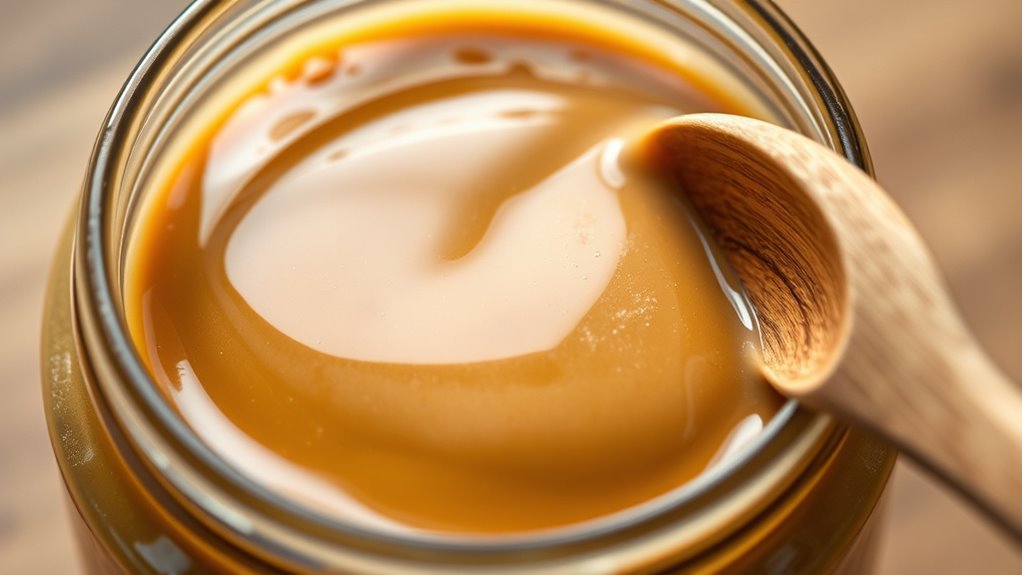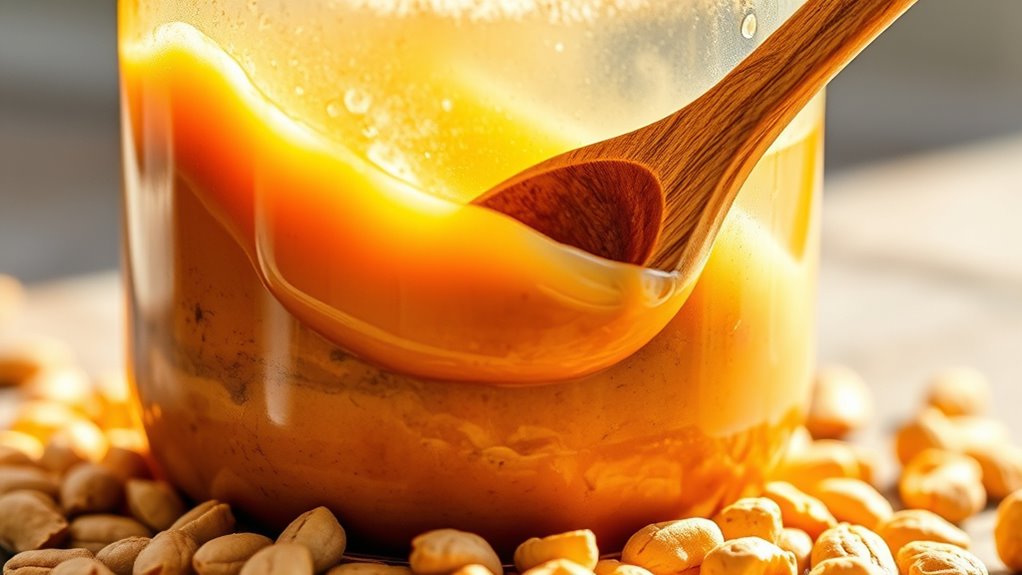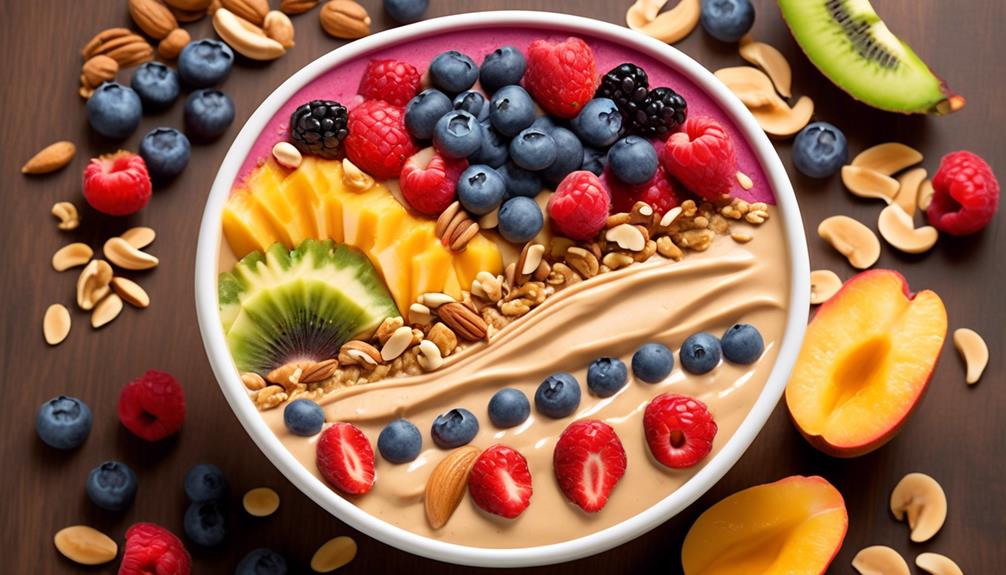Oil separation in peanut butter happens because it lacks stabilizers and preservatives, allowing natural oils to rise. This isn’t a sign of spoilage—just a normal trait of natural products. To fix it, simply stir the oil back into the peanut butter with a spoon or knife for an even mix. Storing the jar upside down can also help keep it consistent. Want to know more about how to manage oil separation effectively?
Key Takeaways
- Oil separation in peanut butter occurs due to the absence of stabilizers and artificial preservatives, reflecting its natural composition.
- This separation is normal and indicates a product made from real peanuts without added chemicals.
- To fix oil separation, simply stir the oil back into the peanut butter for an even consistency.
- Storing peanut butter upside down can help reduce oil separation by redistributing the oil and solids.
- Refrigeration slows oil separation but may make spreading more difficult; find a balance that works for you.

If you’ve ever opened a jar of natural peanut butter, you’ve likely noticed a layer of oil floating on top. This oil separation happens because natural peanut butter lacks the additives and stabilizers found in conventional peanut butter. Without artificial ingredients or natural preservatives to keep the oil and solids mixed, the oil inevitably rises to the top over time.
Natural peanut butter’s oil separation is normal, a result of its lack of stabilizers found in conventional brands.
The primary culprit behind this separation is the absence of texture stabilization. In products that contain hydrogenated oils or emulsifiers, the mixture remains smooth and homogenous, but in natural peanut butter, the ingredients simply don’t stay together as well. When you see that oily layer, it’s just the natural oils from the peanuts separating from the solids. That said, this doesn’t indicate that the peanut butter has gone bad; it’s a normal characteristic of a product made from real peanuts without the added chemicals.
To fix this issue, you can stir the oil back into the peanut butter. It might take a bit of effort, but once it’s mixed back in, you can enjoy that rich, nutty flavor without any oily residue. If you find yourself frustrated with the oil separation, consider storing the jar upside down. This simple trick can help redistribute the oil and solids, making it less likely for the oil to separate again.
While some brands incorporate natural preservatives or stabilizers to reduce oil separation, many consumers prefer natural peanut butter for its minimal ingredient list. If you’re committed to keeping things as natural as possible, just remember that oil separation is a sign of a quality product. Embrace the process of stirring, and you’ll reap the benefits of a wholesome peanut butter experience. Additionally, understanding the importance of sizing and load-planning tools can help you choose the right type of peanut butter for your dietary needs.
You can also experiment with different storage methods, like keeping it in the fridge, which can slow down the separation process. However, it’s worth noting that cooling will thicken the texture, making it harder to spread. Finding the right balance that works for you may take some trial and error, but it’s worth it to enjoy a product that’s closer to its natural state.
In the end, understanding oil separation helps you appreciate the purity of natural peanut butter. Embrace the oil, stir it in, and savor every spoonful of that delicious, nutty goodness.
Frequently Asked Questions
Is Oil Separation in Peanut Butter Harmful to Health?
No, oil separation in peanut butter isn’t harmful to your health. It’s a natural occurrence and doesn’t affect the nutritional impact of the product. You’re still getting the same healthy fats, protein, and nutrients. Just stir it back in, and you’re good to go! There are no negative health implications from this separation; it simply reflects the peanut butter’s natural ingredients and lack of stabilizers. Enjoy your peanut butter without worry!
Can I Use Oil From Peanut Butter in Recipes?
Yes, you can definitely use the oil from peanut butter in recipes! Those natural oils add a rich flavor and can enhance your dishes. Just make sure to stir it back into the peanut butter for even consistency, or use it separately in salad dressings or baked goods. To prevent excessive separation, consider using proper storage methods, like keeping it in the fridge or tightly sealing it after each use. Enjoy experimenting!
How Long Can Peanut Butter Last After Opening?
Once you open it, peanut butter generally lasts about three to six months if you store it properly. To extend its shelf life, keep it in the refrigerator after opening. This helps maintain freshness and flavor. Always check for any off smells or changes in texture before use. Sticking to these storage tips will help you enjoy your peanut butter longer and keep it tasty for your recipes!
Does Oil Separation Affect the Taste of Peanut Butter?
Oil separation doesn’t usually affect the taste of peanut butter, but it can change the texture consistency. Think of it like a classic peanut butter cup—delicious but sometimes a bit messy! You’ll still enjoy that natural flavor you love. Just give it a stir to mix the oil back in, and you’ll have that creamy goodness again. So, don’t worry; your peanut butter’s taste remains as delightful as ever!
Are There Any Brands That Don’T Separate?
Yes, there are brands that offer peanut butter with minimal oil separation. Look for options labeled as “stir-free” or “no-stir.” These brands often use stabilizers to maintain brand consistency and reduce natural variation in texture. However, keep in mind that even the best brands might still experience some separation over time. Always check the ingredients to confirm you’re getting a product that meets your preferences for texture and flavor.
Conclusion
In summary, oil separation in peanut butter can be a pesky issue, but it’s manageable. By choosing natural brands, stirring it well, or even using a trusty rubber band to keep your jar sealed tight, you can enjoy a smoother spread. Think of it like riding a horse-drawn carriage in a world of Teslas – a little old-fashioned approach can still lead to great results. With these tips, you’ll savor your peanut butter without the oil drama!









